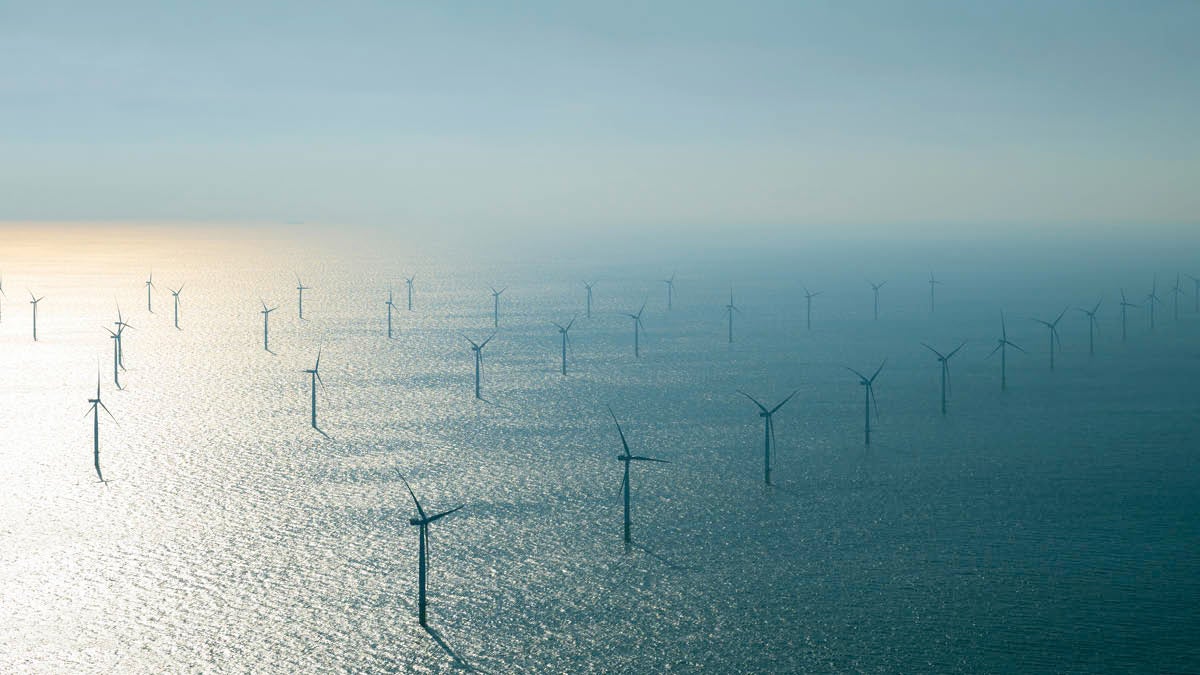
Both the UK and the European Union have pledged to achieve net-zero carbon emissions by 2050. These targets are incredibly ambitious, demanding rapid change and significant investment.
To reach net-zero, Europe’s transportation, factories and buildings need to be powered by sustainable electricity. In 2018, the Continent generated an astonishing 2800 tera-watt-hours of power and providing this incredible amount of electricity from solar, wind and hydro will be the defining challenge of the race to net-zero carbon emissions.
One of the key pillars of this effort is offshore wind power, a resource that has gone largely untapped until recently. Further away from land, wind speeds are higher and more predictable, and higher wind speeds produce far more electricity; for instance, a turbine in 24km/h wind generates double the energy of a turbine in 19km/h wind.

Combined with more accurate weather forecasting and remote, data-based power management, offshore wind has the potential to generate a significant proportion of Europe’s energy.
Each new gigawatt of offshore wind power requires up to €250 million in terms of power cables, and we are proud to provide them
Currently, Germany and the UK lead the way in offshore wind power. Over half of the world’s total offshore wind power is generated by these two countries. However, to meet the ambitious net-zero carbon goals, Germany, the UK and the rest of Europe must greatly increase their number of offshore wind turbines.
Fortunately, technological improvements have made offshore wind farms increasingly viable. The EU recently announced plans to increase the amount of power it generates through offshore wind by 25 times by 2050. It currently produces 12 gigawatts (GW) and aims to increase this to 60GW by 2030. The UK currently generates 10GW from offshore wind and the government has increased its 2030 generation goals from 30 to 40GW.
Outside Europe, other nations are also investing heavily in offshore wind. Over the next decade, China intends to build 50GW of offshore wind capacity and India plans to build 30GW. The International Energy Agency estimates that, by 2030, the industry in the United States will grow by 13 per cent and continue to add 20GW of capacity every year. Globally, experts estimate offshore wind will provide 200GW of clean power in the next decade alone.
These worldwide goals are driven by technological improvements. Larger turbines are currently coming online which can each generate 15 meg-awatts, enough power to support 20,000 homes, and offshore wind farms are becoming more efficient. A better understanding of turbine behaviour in rough seas also means turbines can be built further out, where winds are far stronger.
Another important development comes in the form of floating offshore wind farms. Currently, most wind turbines are fixed to the seabed. But this becomes impractical at water depths greater than 60 metres. Yet some 80 per cent of the world’s wind potential is found in waters deeper than 60 metres. To reach this potential, we must use turbines mounted on floating platforms moored to the seabed.
The coming decade’s ambitious offshore projects will be the most complex, risky and demanding efforts to date. Nexans can deliver on these demands with the breadth of capability, deep expertise and excellence in execution.
As electrification specialists, Nexans enables the offshore wind industry to electrify the future by harnessing the power of wind. We already produce every type of subsea and land cables that connect turbines to grids and we are the number-one supplier of the subsea high-voltage export cables that bring the power onshore. And we expertly install them to ensure project success.
Each new gigawatt of offshore wind power requires up to €250 million in terms of the inter-array cables and export cables, and we are proud to provide them. We have already delivered cables to ten offshore wind pro-jects in the UK and, inside the wind turbines themselves, we offer plug-and-play harnesses that are driving the cost of new turbines down. This year we will launch the CLV Nexans Aurora, the world’s most advanced cable-laying ship, and approximately half the new installations in Europe will use Nexans products.
The future is bright for offshore wind power. Further optimisations of hardware, control software and cable infrastructure are underway that will bring installation and operating costs even lower, making off-shore wind an undeniable option. At the same time, the supply chain is ramping up to support the coming decade’s projects.
At Nexans, we are leading the charge to the new world of electrification – safer, sustainable, renewable, decarbonised and accessible to everyone, connecting us all to new opportunities, technologies and behaviours that will build a better future.
For more information please visit nexans.com
Sponsored by

Both the UK and the European Union have pledged to achieve net-zero carbon emissions by 2050. These targets are incredibly ambitious, demanding rapid change and significant investment.
To reach net-zero, Europe’s transportation, factories and buildings need to be powered by sustainable electricity. In 2018, the Continent generated an astonishing 2800 tera-watt-hours of power and providing this incredible amount of electricity from solar, wind and hydro will be the defining challenge of the race to net-zero carbon emissions.
One of the key pillars of this effort is offshore wind power, a resource that has gone largely untapped until recently. Further away from land, wind speeds are higher and more predictable, and higher wind speeds produce far more electricity; for instance, a turbine in 24km/h wind generates double the energy of a turbine in 19km/h wind.

